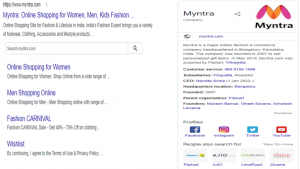Google addresses about 63,000 search queries a second: which is 5.6 billion per day. According to the World Wide Web Size Project report
There are around 50 billion web pages indexed in Google.
So now comes the question, Is your website well-optimised to rank on the Google result page?
Hope! All the techniques of On-Page SEO are included on your website to improve the ranking.
There is a critical part of on-page SEO: which is ignored several times by SEO professionals. It is no other than structured data. It’s paramount to SEO that improves your website presence in search results significantly.
Expect you are aware of it and wouldn’t have missed it. But If you’re unaware and do not include Structured Data in SEO, then you are blocking the way of Google crawlers to understand your website.
Structured data is the key to making Google understand your website and target audience better. It’s an opportunity to give Google more information about your site and its users. The goal of using structured data is to make your website more appealing to search engines, leading to higher rankings in search results.
The use of Structure Data in SEO is gaining adoption but is still on the non-priority list for the maximum number of brands. According to a report, 50% of businesses don’t include structured data on their website.
If you are a digital marketer, SEO, or someone who wants to improve their Google Search Presence, then this blog is for you,
In this blog, I will explain how Structured Data in SEO can make your content more search-engine friendly, increase your search-engine ranking, and give you an advantage over your competitors. If you are an SEO professional, this blog is essential for you.
Before moving in-depth, let’s know more about structured data.
Structured data is a type of markup language used to describe the semantic and structured nature of data in a website. There are a few different types of structured data, but essentially you can use it for two purposes. The first is to tell Google about the structure of your website, and the second is to help people find what exactly they’re looking for on your site. Structured data can be used in conjunction with HTML or JSON-LD (JSON-like documents) to help improve search results, but it’s not just limited to that — it can also help build rich snippets and improve site speed and reduce data load times.
As per Google:
“The structured data format is a standardised way to provide information about a page and classify its content.” Let’s take an example of an eCommerce website. It displays sitelinks like shopping for women, Men shopping, carnival sales, login/signup, including the site link search box. It even includes rich snippets to give additional information about the company like its establishment year, founder, social media pages, etc.
As a result, the user doesn’t have to waste time searching for any product of their choice. Any user looking for sunglasses can type the keyword in the site link search box and access that particular page directly.

Google uses structured data that it finds on the web to understand the content of your website and gather information about the web and the world in general.
In other words, we can say it is a user-friendly approach that not only helps users but even helps Google to understand your content better and faster.
It becomes confusing for beginners stepping into careers in digital marketing and SEO when it comes to structured data. Because somewhere, it mentioned schema structured data and schema markup in others. And if you have read any blogs or articles about schema, you must have gone through a term called “rich snippet”. Let’s understand the schema and rich snippets.
What is Schema?
Schema Markup or Schema is a standard computing language that helps search engines like to understand the websites’ content. Accordingly, it displays your content within the search results attractively and efficiently.
Schema.org was developed by top search engines like Google, Bing, and Yahoo in 2011 to provide and support a universal format for structured data that can be used on any website. It gives users a personalised search experience in rich results form.
Usually, three structured data formats are supported by the Google search engine. JSON-LD, RDFa and microdata. Out of three, JSON-LD is the most popular markup script and the preferred version of structured data for Google.
What are Rich Snippets?
Rich snippets are some additional information about the content of a website on a search engine page that includes ratings, price, recipe, etc. The structured data that we provide using schema lets the Search engine know what users can find on your website. It enables the search engine to present web content prominently and attractively in the search engine.
Major Benefits of Using Structured Data:
Although it is not a ranking factor for Google there are several advantages of using Structured Data in SEO, mainly for eCommerce brands. let’s have a closer look at the benefits it offers.
1: One of the primary reasons for using structured data is to help search engines understand the content of the website better.
2: It displays the content in the form of a rich snippet within the result page and increases the overall click-through rate(CTR) of the website.
3: A website having structured data get indexed faster. As we know there are more than billions of web pages and search engine usually keeps out of their index for those pages having low-quality content. Structured data help search engine to understand it better and find your content easily.
4: Rich snippets give a positive impact on searchers. It gives additional information like ratings, price, and location that increase the chance of a conversion.
5: The use of structured data not only enables the search engine to understand the content of the website but even helps users to find out easily what they are looking for. Using a search box snippet allows users to find out what exactly they are looking for. As a result, it reduces the bounce rate.
6: It improves the ranking of keywords as search engines associate web content with more topics and sub-topics.
Types of Schema Markup:
As you know structured data mark up all types of data to describe them in more detail for the search engine to understand, so that the search engine can give relevant information to the user searching for the relevant topic.
Let’s check out some popular schema markup used
(a)Product Markup:

Product schema markup is most beneficial and essential for eCommerce brands. It enables the search engine to understand the product information, like price, availability in stock, and reviews. This benefits eCommerce sites by attracting more users to their products by providing relevant information. As well helps search engines understand the products offered by the brand.
(b) Organization Markup:

You must have gone through this schema markup. The Organization Schema Markup gives elaborates more information about a company, including its official name, logo, contact number,headquaters, founders, social profiles, and, more.
(c) Article Schema Markup:

Article Schema Markup is mainly used in news and blog posts. It allows the search engine to understand the content of your article easier and enables your result page listing to stand out with rich results that may have a high Click-through rate from searchers.
(d) Breadcrumb Markup:

Breadcrumb Schema Markup list the links of the path that leads to the current page where it ends up. It usually helps users to get page positions within the site hierarchy. The search engine uses breadcrumbs in the body of the web page to categorize the information from the page in search results. Additionally, it is useful in reducing the bounce rate of a website.
(e) Video Markup:

When it comes to video content it’s very difficult for the search engine to crawl. Adding a video Schema Markup makes search engine crawlers appear in video search results.
(f) Recipe Markup:

It is designed especially for websites related to cooking and recipes. Adding recipe schema markup enables the search engine to find out additional information about your recipes, such as cook time, ingredients, nutrition information and reviews. Additionally, it helps users to get more details about it easily.
(g) Person Markup:

Schema person markup may not be new to you. You must have seen this markup several times. It lists details of an individual, like name, birthday, address, education and family members.
(h) Job Posting Markup:

As the name suggests, job posting schema markup is generally used in careers pages. It allows to markup job postings on the search page so that users can find them easily. Additionally, It enables search engine crawlers to find and index job postings, which can impact on website’s overall rank.
(h) Event Markup:

Event schema markup informs search engines that the particular webpage is related to an event that will be held either online or offline and gives additional pieces of information like date, location, and price.
(i) Local Business Markups:

The Local Business schema Markups is specially meant for local businesses or outlets of an organisation. Implementing this markup enables customers to find out certain information like its location, opening hours, price tag, opening hours and contact info.
Apart there are several schema markups, such as how-to, FAQ, Sitelinks, Offers, and more.
How to add structured data to the website?
I guess now it’s time to implement Structured Data in SEO On-Page of your website. Let’s know how to add it to your website.
Adding structured data is not a herculean task. But requires a bit of practice and logical thinking.
(Note: Don’t add structured data in a shake of rich results. Remember its sole purpose is to help search engines to understand the webpage and how they could help users.)
Last but not least, try to use JSON-LD format as it generates clear, human and machine-readable documentation and even makes the work of developers and testers easier.
1: Generate Markup:
There are two ways to create structured data,
(1) Write the script manually.
You can write your own script by taking help from schema.org.However it’s a complicated process. You need to have a bit of experience in coding. Additionally, it’s time-consuming and has more chances to get errors.
(2) Take the help of a schema markup generator.
There are several online schema markup generators available for free that will create structured data automatically. Only you need to select the type of markup you need for your website. Some of the popular markup generators are:
Google Structured Data Markup Helper.
Schema Markup Generator (JSON-LD) by Merkel.
If you are building your website in WordPress then it’s quite easy. There are several plugins available that can ease your task. Some of those plugins are Yoast SEO, Schema App, Yoast WooCommerce SEO, and others.
2: Test your structured data:
It’s crucial to test your structured data before implementing it on your website. There are testing tools like Schema Markup Validator and Rich Result Test, where you can validate your schema markups.
3:Implement Schema to your website:
Deploying structured data doesn’t take a long time. However, you need to be careful before implementing it. There are two ways to add your scripts.
(1) Adding Manually:
If you have created the markup in JSON-LD format, then simply paste the code directly into the <head> or<body> of your HTML.
(2) Google Tag Manager:
This tool can help you to implement your structured data to your pages directly without adding them in codes.
For WordPress websites, if you are using plugins like Yoast SEO, you don’t need to get worried. It will automatically implement structured data.
Conclusion:
Structured Data in SEO is important and useful for many reasons. Using structured data to markup your website on search engines will help improve your site’s optimization, and will also make it easier for Google to crawl, index and understand your content. More data about you and your pages that are out there in the public domain will also lead to higher visibility for your content, which of course is something that everyone wants. Hopefully, this guide has helped you to understand how Structured Data in SEO can be useful for you as a webmaster and, more importantly perhaps, it has also shown you how easy it is to start using it.
As a brand, if you are looking for any services regarding SEO, then Gloify will guide you in a better way. Don’t wait till your competitor occupies your space online. Reach out to us today.

